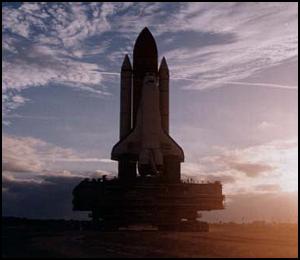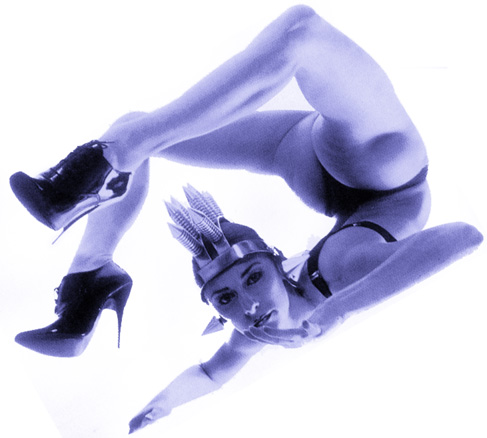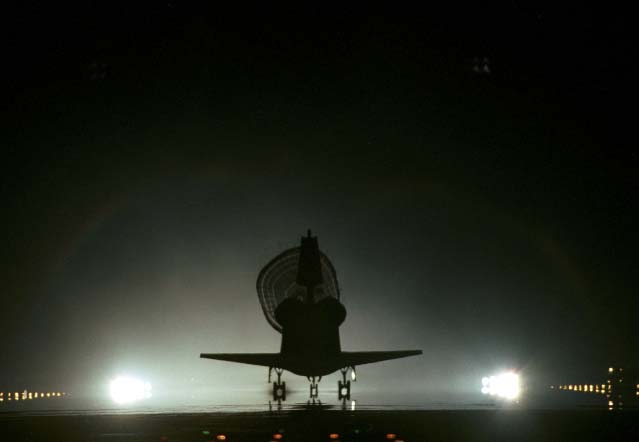|
Forging
relationships between
|
|
The notion of collaboration mentioned in T minus 3 unveils a number of possible interactions between artists and the space community. But it also unveils the fact that these collaborations will have to happen under the auspices of something much larger than the module itself. To offer a vision such as the ISADORA Module without discussing the greater implications involved would seem rather shallow. So I will just share some thoughts on this "bigger picture" based on the interviews and secondary data I came across during my research period. I must add that the implications for collaboration between the artists and scientists within the space establishment demands further research.
Possible Interactions
In the diagram above I have created an interaction wheel which shows possible interactions between artist, astronauts, the ISADORA Module, the cultural sectors, the space program, distributors and audience. Drawing an arrow from one element of the interaction wheel to all others reveals possible interactions. If this is applied to a Pre-flight scenario, an In-flight scenario and a Post-flight scenario, one can start to see the workings of an entire art program within a space agency. To follow I discuss some of these interactions within the three scenarios I just mentioned: Pre-flight, In-flight and Post-flight.
Pre-flight
An Arts and Humanities Directorate A certain amount of autonomy must be given to a division within the human spaceflight directorate of the agency that will develop ISADORA. This is to ensure that art projects do not become mere PR events for the agency and are not curated by people who do not have an art-related background. Selection Selection of artist candidates should be carried out by application. But I would not be against inviting the occasional high profile artist or Nobel laureate to fly. The Selection Committee should look for people who are willing to share their experience with the largest audience possible, they should be good team-workers and also good improvisers. The selection of the actual Selection Committee or curators is a tricky one. Care should be taken to avoid tendencies towards one sort of art being carried out in ISADORA. Selection of both artists and curators should be broad-based in art tendencies and nationalities. I suggest that for every 4 artists from ISS countries that one be from a non-ISS country thus making it a truly international endeavour. Plus a rotation within the disciplines selected should take place to keep the art-work varied; first send a choreographer and dancers, then a filmmaker with actors, then a musician and band, for example. Finally, to what extent are the artists involved in the space program? Artists will probably hold temporary positions as astronauts (as was intended with NASA’s citizens program which was to launch teacher Christa McCauliffe into orbit aboard Challenger). But the program should also be open to allowing for the truly dedicated to become full-time art-astronauts.
Numbers When complete, the ISS will hold a crew of 7. Of these seven, two to three should always be in the arts, humanities or engaged in habitability research for ISADORA’s lounge. Approximately 800 people have been in space. Most of who were scientists. It’s now time to start balancing things out. Let’s say 2 artists are sent every three months. That’s only eight artists in one year. Depending on launch schedules maybe artists missions could be 2 months instead of 3 months allowing twelve artists to go up in one year. That would still make only 180 artist going up in 15 years. All the more reason to start incorporating the arts and humanities into space exploration ASAP! Training ISADORA candidates will have to undergo a certain degree of regular astronaut training including neutral bouancy training in water tanks if artists are going to engage in any Extra Vehicular Activity. Cross-Cultural Familiarization Artists will get to know astronauts’ work and astronauts should become familiarized with artists’ work through art-science workshops that will take place prior to flight. A high level of interaction should be encouraged. Preparation A scale version of ISADORA should exist on the ground. It should go without saying that artists should know how to operate all equipment on board ISADORA. Some artists or performers may have technicians controlling lighting and other audiovisual hardware from ground control. It is important to have a scale version on the ground so the technicians can become versed in all equipment to better assist the artist in orbit. Ground to Orbit Interaction Artists on the ground at mission control can engage with artists or astronauts in orbit to exchange ideas or to test props that they will use when their turn to fly comes. Long Duration Flight Research Because of the lounge aspects of Isadora artists should also become familiarized with scientists, engineers, space architects who are going to conduct habitability research in ISADORA and vice versa. I see ISADORA’s lounge being of great interest to researchers, in both agencies and academia involved in long duration flight research, habitability research, and moon, mars and space station architecture. Unmanned Works Artists who develop unmanned works can collaborate with space scientists in all other directorates of a space agency to have their works launched and installed on the exterior of ISADORA. Placing experiments on the exteriors of modules or on trusses is common practice. As I mentioned in T minus 1 there could be a need for a palette attached to the ISADORA Module for unmanned artistic expression. Cost I would leave a cost analysis for later research. Space costs are too astronomical and often conflicting for me to go into them. I’ve heard reports of the ISS costing 30 billion dollars. I’ve also heard reports of the ISS costing ultimately costing tax payers 100 billion dollars. So all I could say is that an ISADORA module might cost anywhere from 200 million to 500 million to build and 420 million to launch (almost one billion all together). A simplistic suggestion: If each of the ISS countries would contribute 30 million for its construction and 25 million into a launch fund, it would get done. It is important to note that the Museum of Modern Art in New York City is currently undergoing a massive reconstruction which will cost 500 million dollars. So the money for a cultural venture such as ISADORA does exist.
In-flight
Dancer Tamasin Nolan from Garry Stewart’s "Helmet". This photo by Harold David has been tilted to make her look like she is floating. 48 The Art Menace (Freedom to Produce) Art in space should be as free from earthly constraints as possible. The methods of artists differ greatly from the methods of scientists and we can’t be expected to produce using the scientific method. Although scientists aren’t sure of the results of an experiment they are fully aware of what they will do when carrying out an experiment. Artists, on the other hand, often don’t even have a clue as to what they are going to do in certain creative situations. I myself have gone into studio to let a piece "come to me". A good example of art method is in some advice that Martha Graham gave to Agnes DeMille in a letter: There is a vitality, a life force, a quickening that is translated through you into action, and because there is only one of you in all time this expression is unique. And if you block it, it will never exist through any other medium and be lost. The world will not have it. It is not your business to determine how good it is, nor how valuable it is, nor how it compares with other expressions. It is your business to keep it yours clearly and directly, to keep the channel open. You do not even have to believe in yourself or your work. You have to keep open and aware directly to the urges that motivate you. Keep the channel open. This method of exploration, this blind (yet illuminated) navigation, is going to demand a lot of understanding on the part of the space community; to actually send someone up without knowing what they are going to do. Lack of understanding in this area would result, in my opinion, the greatest obstacle in forging a relationship between artists and scientists. Hence, the title of this section: The Art Menace. This is why some measure of autonomy for artists functioning within the space establishment is necessary. I’m quite sure most artists would find it quite absurd to go into space already having to know what they are going to produce. The artist must be free to improvise, change his or her mind in the middle of a project and truly explore the vast and probably overwhelming poetic potential of space. Freedom to produce and understanding on the part of space administrators will be key to artistic innovation in space. (Although there is something to be said about creating under oppressive regimes. Hmmm… perhaps protest music may be the first art form to come from the ISS?) Performance/broadcast Performance or any other form of work done in space will have many distribution outlets; internet, cable TV, print, cinema, musea, etc. Some artists may want audience feedback and participation and may explore more interactive forms of broadcasting. But if there is one constraint or demand that should be placed on artists going to ISADORA, it should be that they share their work and experience with the largest Earth audience possible. Contracts and Financial Dealings Negotiations will take place with broadcasters and other distributors of the work produced in orbit. I confess I don't know how broadcast rights work. The business model would have to resemble, I would imagine, the broadcasting of a World Cup of Soccer game. Certain companies have exclusive rights but somehow everyone in the world, of all incomes, from the Japan to Cameroon manages to watch the games. Whatever business model is used for such a widespread broadcast, it should be implemented for broadcasts from ISADORA. But it is essential that the art done on ISADORA get out to as many people as possible. Exclusive broadcast rights to a select population that subscribes to a specific cable channel, for example, cannot be an option. This would defeat the purpose and meaning of the words: International Space Station. Test-bed for Commercialization In this context mentioned above, ISADORA may well become a test-bed for commercialization of the ISS. I'm sure that the performance of a high profile artist in space will move much more money than all the scientific experiments on the ISS combined. I don’t want to suggest, however, that profit will or must come out of a performance. Manned space flight is still too damned expensive to yield profits at this point in time. Nonetheless, I’m sure that high-profile performances in space would yield interesting economic numbers for studies in commercialization of space. Orbit to Ground The artist in flight should dedicate some of his or her hours a week to work with the next artist or group of artists on the ground preparing to go. The artist in flight should not only bring along his or her luggage and equipment but they should bring some, costumes, props, etc of the next in line that need testing. These tests will be carried out via video link to the ground artist at ground control. Interviews, Articles, Lectures Just as it happens with astronauts, artists will probably have to engage in PR events such as giving interviews. They can also give lectures via video link on creating in zero gravity in academic settings. Some artists may relay their experiences by writing for newspapers or magazines while they are in space. Critique Most artists appreciate feedback during their creative process. Artists working in the space program on the ground as well as others can critique works in progress being done by their colleagues in space. Creative Collaboration with Astronauts Artists are very enthusiastic to collaborate with the rest of the crew of the ISS. Artists and astronauts will bring new light to each others work making the ISADORA experience rich for both the arts and sciences. Artists will organize workshops in orbit and even involve astronauts and dancers and performers in live broadcasts of their works. Some astronauts of course may only be observers, passive audience. Long Duration Flight Research Many designs and experiments can be flown to ISADORA for testing. Architects and designers involved in these fields should also be flown to ISADORA. A good balance will have to be struck between all those interested in using ISADORA as a performance venue and a place for habitability research. Habitability research carried out by artists and designers in the ISADORA lounge will yield verifiable research into architecture of future space stations, bases on the Moon, Mars spacecraft design and Mars habitation architecture. Conflict Artists wanting to use ISADORA as a studio should not conflict with astronauts wanting to use the lounge for downtime. But as creative and habitability research increase in space there will eventually be the need to launch a second module in order to separate the functions of Studio and Lounge. Unmanned Works Some artists I talked to expressed a desire to do EVA's (Extra Vehicular Activities or space walks). Artists could be the ones responsible for placing unmanned works of other artists on the exterior of ISADORA or on a palette outside the station.
Post-Flight
Press conferences, interviews, lectures Nothing too different here. Only difference here will be the paparazzi (depending on how well you did in space). Work on ground Artists may find means to apply what they learned in orbit to the work they do on the ground. Recommendations Since a module like ISADORA is such a new idea, artists and researchers may have to dedicate some time to revising and implementing any improvements needed for ISADORA’s studio and lounge features. Preparation The artists experienced in zero-G will have more to offer other artists preparing to go and could be incorporated into the training of new artist-candidates. Ground to Orbit Interactions Artists experienced in zero-G will have more to contribute in critiques and experiments in video links with artists in space. Continuity in Space Program Depending on the artist’s involvement in the space program, artists may stay on as career artist-astronauts and qualify to fly a second or third time. If they are involved in a citizens-type program, after flight they will probably do their share of interviews and lectures for a period and then eventually go back to their miserable, under-funded pensionless lives as ground artists. Oy vay! Artists are go! So conclusions from the interviews were drawn up as a design for ISADORA in chapter T minus 1 while this final chapter has drawn conclusions that lay the ground to an art program within a space agency. It would be silly for me to propose such an expensive project without discussing its implications for the space program. ISADORA is a huge endeavour that would cost hundreds of millions and involve new areas of the cultural and private sectors into the realm of space exploration; areas of society that never thought they were even "entitled" to space. But artists should start thinking they are entitled to space. Space exploration is not the province of science alone. Poets, dancers, musicians, theatre and filmmakers, we can all start to allow our minds to go there. And the more we do, the more likely an ISADORA Module will be built. Some artists have, for more than a decade, collaborated with space agencies in getting onto parabolic flights. Some industries are already defying science’s iron curtain on space by proposing alternative commercial, media and tourist modules in orbit. But more will have to be done in order to get the hard sciences and space exploration out of their self-serving mode of exploration. I am convinced, however, that an ISADORA Module is the logical follow-up to manned spaceflight programs. This design proposal is very relevant to the current needs of the space industry. It will broaden the definition and… most importantly… the revelation of space. And, at the same time, my design for ISADORA can serve as a test-bed for research in astronaut well being for long duration flights. In order for ISADORA to fulfil it’s role as the Poetic Shelter I mentioned in T minus 2, it will have to count on the idealism on the part of those who administer the project; a fervour in maintaining high standards of art parallel to those of Isadora Duncan herself. I have bearly talked about her in this thesis but there is a story that she tells in her autobiography about her commitment to art that is worth recounting here: Although my dancing was known and appreciated by many notable people, my financial situation was precarious, and we often worried terribly how to pay the rent of the studio, and, as we often had no coal for the stove, we suffered from cold. Yet, in the midst of this poverty and deprivation, I can remember standing for hours, alone in our cold, bleak studio, waiting for the moment of inspiration to come to me to express myself in movement. At length my spirit would be uplifted, and I would follow the expression of my soul. One day, as I was standing thus, there called on us a florid gentleman with an expensive fur collar on his coat, and a diamond ring. He said: "I am from Berlin. We have heard of your barefoot act." (As you can imagine, this description of my Art shocked me dreadfully.) "I have come from the largest music-hall to make an engagement with you at once." He rubbed his hands and beamed as if he were bringing me a wonderful piece of luck, but I retired into my shell like a hurt snail and replied distantly, "Oh, thank you. I would never consent to take my art into a music-hall." "But you do not understand," he exclaimed. "The greatest artists appear in our hall, and there will be much money. I already offer you five hundred marks a night. There will be more later. You will be magnificently presented as 'The First Barefoot Dancer in the World.' (Die erste Barfuss Tänzerin. Kolossal, kolossal.) Of course you will accept?" "Certainly not, Certainly not," I repeated, becoming angry. "Not on any terms." "But this is impossible. Unmöglich. Unmöglich. I cannot take 'No" for an answer. I have the contract ready." "No," I said, "my art is not for a music-hall. I will come to Berlin some day, and I hope to dance to your Philharmonic Orchestra, but in a Temple of Music, not in a music-hall with acrobats and trained animals. Quelle horreur! Mon Dieu! No, not an any terms. I bid you good day and adieu." Looking at our surroundings and shabby clothes, this German impresario could hardly believe his ears. When he returned the next day, and the next, and finally offered me a thousand marks an evening for one month, he grew very angry, and characterised me as a Dummes Mädel," until finally I shouted at him that I had come to Europe to bring about a great renaissance of religion through the Dance, to bring the knowledge of the Beauty and Holiness of the human body through its expression of movements, and not to dance for the amusement of overfed bourgeoisie after dinner. "Please go away! Allez vous en!" "You refuse on thousand marks a night?" he gasped. "Certainly," I replied sternly, "and I would refuse ten thousand, one hundred thousand. I am seeking something which you don't understand." And, as he left, I added, "I will come to Berlin one day. I will dance for the countrymen of Goethe and Wagner, but in a theatre that will be worthy of them, and probably for more than a thousand marks." My prophecy was fulfilled, for this same impresario had the grace to bring flowers to my loge three years afterwards in the Krol's Opera House, with the Philharmonic Orchestra of Berlin playing for me, when the house was sold out for more than twenty-five thousand marks. He acknowledged his error with a friendly, "Sie hatten Recht, Gnädiges Fräulein, Küss die Hand." (You were right, my dear lady. I kiss your hand.)49 This commitment to Art is one I admire in Isadora Duncan… she always aspired to maintaining the highest ideals, keeping faithful to Art (always written with a capital "A") or what she also called the "holy vision". She was committed to tapping into the "original source". Isadora was committed to the poetic, the soul, the human spirit. If the ISADORA Module is supposed to be, as Fernando Rosa Ribeiro said, the centerpiece of feeling at home on the ISS, then the spirit should be the center-piece of The ISADORA Module. The ISADORA Module will enable artists to explore space and the Earth below with the most precious of instruments. An instrument that we have never put a price on; the instrument that doesn't measure but heals… the instrument that doesn't record but listens… the instrument doesn't hum but sighs… …the instrument is our spirit… And the spirit, revelling in the new dimension of orbit, will undoubtedly surprise us with new forms, images and language that will pour forth from that 90% of the soul that we didn't even know existed. Dancers will enchant us with their share of acrobatics and contact improvisations, but they will surely be sensitized beyond muscle, bone and movement. Theater-makers and actors will emote from their newly found unknown depths. Sure they can perform in broadcasts to audiences of billions but may prefer the ritual of presenting works to a petite audience of seven astronauts aboard the ISS. Astronauts, on the other hand, need not be passive spectators to these strange new works but can be a source of material or, perhaps, explored as another medium by the artist. In terms of music, all I can say is I would just love to hear what the likes of Björk & Milton Nascimento would compose in space, not to mention to see how musicians like Missy Elliot and the Red Hot Chili Peppers would dance let alone behave. And as for installation art, imagine suspended trembling liquids holding up geometric forms or installations outside the module gliding along side the ISS in a space sculpture garden. But of course the arts I have mentioned are "earthly". Only by exploring the poetics of space in space will the artist be able to unveil the constraints and bonds to Earth of which we are not even aware and reveal the ironies of being in space. What for some artists will be the serenity of orbit, others may perceive as the madness of travelling at 28,000 kilometers an hour. What for some will be the womb-like security of life support systems, others may perceive as the looming danger of the vacuum outside. And what for some will be the romantic idea of 16 sun rises a day, others may perceive as the schizophrenia of 45 minute days and 45 minute nights. No, exploration is not the province of science alone. It's time that artists go into space too. The pristine nature of this dimension awaits the arts with unborn art forms. And what a privilege it will be to be able to inaugurate these forms in a place we have always called "the heavens" ... I honestly can't think of anything more poetic.
: : : Fin : : :
Proceed
to EPILOGUE
|

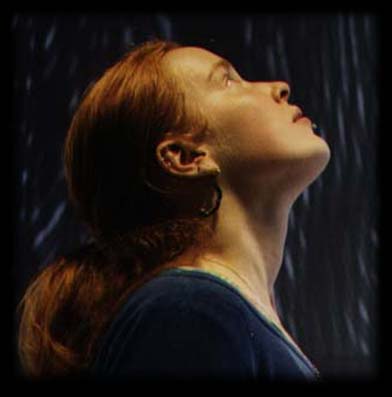
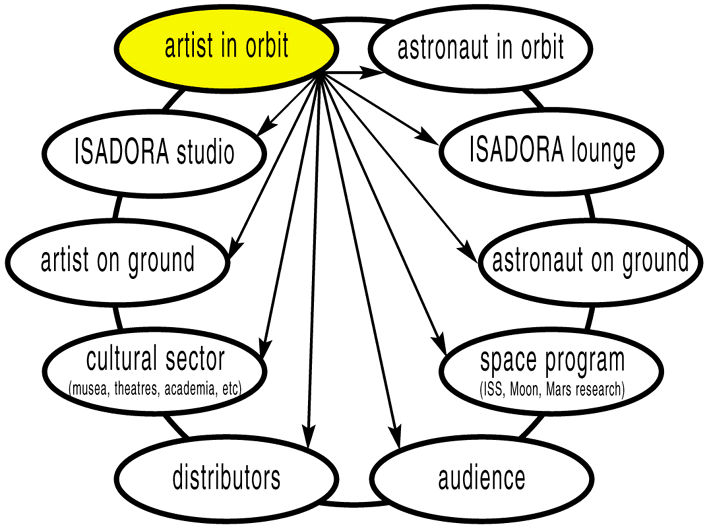 .
.